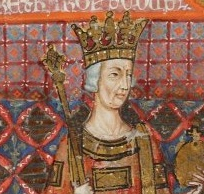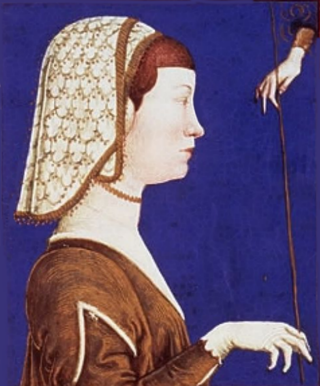Life
Durazzo–Valois conflict
Carafa was born around the middle of the 14th century. His father was Giovannello Carafa and his mother Mariella Mariscalchi. He had three brothers: Niccolò, Tommaso and Gurrello. He married Caterina Farafalla and had seven sons and two daughters: Carlo, Francesco, Tommaso, Antonio, Gurrello, Giovanni Battista, Diomede, Caterina and Diana. Cardinal Oliviero Carafa and Archbishop Alessandro Carafa were sons of Francesco.
In 1384, with his brother Gurrello, Carafa fought for King Charles III against a challenger to the throne, Duke Louis I of Anjou. On 20 December 1392, he was part of the council that declared Charles's successor, Ladislaus, to be of age. On 15 October 1394, he took part in a council convoked by Ladislaus to affirm the kingdom's support for Pope Boniface IX during the Western Schism.
In 1400, Ladislaus appointed Carafa justiciar of the province of Bari and granted him an annual pension from the customs revenue of the port of Bari. That year, he purchased land in Mercurion [ it ] from the Countess Covella Gesualdo. In 1410, he and a cousin purchased the fiefs of Pescolanciano, Boccalino and Vignali with royal permission. In 1415, Queen Joan II confirmed his pension in Bari and appointed him captain of the territory of Montecassino. In 1417, she appointed him justiciar of the Valle di Crati and Terra Giordana [ it ]. In 1419, Carafa purchased the casali of Cupuli and Casacellola from the Origlia [ it ] count of Caiazzo. In 1420, he was named castellan of Torre del Greco.
Aragonese intervention
In April 1420, Carafa was part of a Neapolitan embassy [lower-alpha 1] to Pope Martin V, who supported the claim of Duke Louis III of Anjou to the throne. They travelled by sea to Pisa and met the pope in Florence. There, Carafa opened negotiations with the Aragonese ambassador, García Aznar de Añón. Returning to Naples without papal permission, he informed the queen and of the possibility of an alliance with Aragon and was sent to Sardinia to meet with Alfonso V. [lower-alpha 2] He arrived during the siege of Bonifacio. Alfonso accepted the offer to become Joan's adopted heir and in return defend Naples from Louis. Later accounts emphasise the skill and persuasiveness of Carafa's appeal to Alfonso to come the aid of a lady in peril. On 6 August 1420 at Alghero, Alfonso granted Carafa an annual pension for his services. Carafa was present on 5 September, when Alfonso's ambassadors formalized the adoption in Naples.
On 1 April 1422, Carafa received the fief of Vico di Pantano from Joan. He was also by then a royal seneschal and household knight. That same year, Alfonso ceded him the revenues of the gabelle of the bailliage of Manco at Cosenza and the customs of the port of San Lucido. In 1423, Joan granted him the tax revenues of Vico di Pantano. In the fall of 1423, when the conflict between Joan and Alfonso spilled out into the open and she renounced the adoption, Carafa sided with Alfonso. When Alfonso opted to return to Spain, Carafa sent his son Diomede and his nephew Caraffello with him. In July 1424, when an Aragonese fleet arrived in Naples to support Alfonso's brother Peter, Carafa engineered riots in favour of the Aragonese. After the queen's victory, he fled to Sessa Aurunca.
Retirement and death
Carafa never abandoned the Aragonese cause. Joan died in 1435 and Alfonso immediately contested the succession with René of Anjou. Carafa died on 10 October 1437 or 1438 [lower-alpha 3] and was buried in San Domenico Maggiore. In his testament, he encouraged his relatives to be faithful to the cause he had supported.
A monumental tomb was built for Carafa between the 1440s and 1480s, probably by the workshop of Jacopo della Pila [ it ] on the orders of his son Diomede. An inscription commemorates its construction and celebrates Carafa as the man responsible for bringing Alfonso to Italy:
Thanks to me, Alfonso arrived on our coasts in order to bring peace to the Italians. Only the piety of his descendants is responsible for this tomb, and it is offered as a gift to Malizia.

Alfonso the Magnanimous was King of Aragon and King of Sicily and the ruler of the Crown of Aragon from 1416 and King of Naples from 1442 until his death. He was involved with struggles to the throne of the Kingdom of Naples with Louis III of Anjou, Joanna II of Naples and their supporters, but ultimately failed and lost Naples in 1424. He recaptured it in 1442 and was crowned king of Naples. He had good relations with his vassal, Stjepan Kosača, and his ally, Skanderbeg, providing assistance in their struggles in the Balkans. He led diplomatic contacts with the Ethiopian Empire and was a prominent political figure of the early Renaissance, being a supporter of literature as well as commissioning several constructions for the Castel Nuovo.

Ferdinand I, also known as Ferrante, was king of Naples from 1458 to 1494.

Charles II, also known as Charles the Lame, was King of Naples, Count of Provence and Forcalquier (1285–1309), Prince of Achaea (1285–1289), and Count of Anjou and Maine (1285–1290); he also styled himself King of Albania and claimed the Kingdom of Jerusalem from 1285. He was the son of Charles I of Anjou—one of the most powerful European monarchs in the second half of the 13th century—and Beatrice of Provence. His father granted Charles the Principality of Salerno in the Kingdom of Sicily in 1272 and made him regent in Provence and Forcalquier in 1279.

The Kingdom of Naples, also known as the Kingdom of Sicily, was a state that ruled the part of the Italian Peninsula south of the Papal States between 1282 and 1816. It was established by the War of the Sicilian Vespers (1282–1302), when the island of Sicily revolted and was conquered by the Crown of Aragon, becoming a separate kingdom also called the Kingdom of Sicily. This left the Neapolitan mainland under the possession of Charles of Anjou. Later, two competing lines of the Angevin family competed for the Kingdom of Naples in the late 14th century, which resulted in the death of Joanna I by Charles III of Naples. Charles' daughter Joanna II adopted King Alfonso V of Aragon as heir, who would then unite Naples into his Aragonese dominions in 1442.

James II, called the Just, was the King of Aragon and Valencia and Count of Barcelona from 1291 to 1327. He was also the King of Sicily from 1285 to 1295 and the King of Majorca from 1291 to 1298. From 1297 he was nominally the King of Sardinia and Corsica, but he only acquired the island of Sardinia by conquest in 1324. His full title for the last three decades of his reign was "James, by the grace of God, king of Aragon, Valencia, Sardinia and Corsica, and count of Barcelona".

Ladislaus the Magnanimous was King of Naples from 1386 until his death and an unsuccessful claimant to the kingdoms of Hungary and Croatia. Ladislaus was a skilled political and military leader, protector and controller of Pope Innocent VII; however, he earned a bad reputation concerning his personal life. He profited from disorder throughout Italy to greatly expand his kingdom and his power, appropriating much of the Papal States to his own use. He was the last male of the Capetian House of Anjou.

Muzio Attendolo Sforza, was an Italian condottiero. Founder of the Sforza dynasty, he led a Bolognese-Florentine army at the Battle of Casalecchio.

Isabella was suo jure Duchess of Lorraine, from 25 January 1431 to her death in 1453. She was also Queen of Naples by marriage to René of Anjou. Isabella ruled the Kingdom of Naples and her husband's domains in France as regent during his imprisonment in Burgundy in 1435–1438.

Joanna II was reigning Queen of Naples from 1414 to her death, when the Capetian House of Anjou became extinct. As a mere formality, she used the title of Queen of Jerusalem, Sicily, and Hungary.

Louis III was a claimant to the Kingdom of Naples from 1417 to 1426, as well as count of Provence, Forcalquier, Piedmont, and Maine and duke of Anjou from 1417 to 1434. As the heir designate to the throne of Naples, he was duke of Calabria from 1426 to 1434.

Giovanni Antonio (Giannantonio) Orsini del Balzo was a southern Italian nobleman and military leader; he was Prince of Taranto, Duke of Bari, Count of Lecce, Acerra, Soleto and Conversano, as well as Count of Matera (1433–63) and of Ugento (1453–63).

Oliviero Carafa, in Latin Oliverius Carafa, was an Italian cardinal and diplomat of the Renaissance. Like the majority of his era's prelates, he displayed the lavish and conspicuous standard of living that was expected of a prince of the Church. In his career he set an example of conscientiousness for his contemporaries and mentored his relative, Giovanni Pietro Carafa, who became Pope Paul IV.

Giovanni Caracciolo, often called Sergianni, was an Italian nobleman of the Kingdom of Naples, prime minister and favorite of queen Joan II of Naples.

Castel Nuovo, often called Maschio Angioino, is a medieval castle located in front of Piazza Municipio and the city hall in central Naples, Campania, Italy. Its scenic location and imposing size makes the castle, first erected in 1279, one of the main architectural landmarks of the city. It was a royal seat for kings of Naples, Aragon and Spain until 1815.

Jacopo Caldora or Giacomo Caldora was an Italian condottiero.

Eleanor of Naples was Duchess of Ferrara by marriage to Ercole I d'Este. She was the first duchess of Ferrara, and mother of many famous Renaissance figures. She was a well known political figure, and served as regent of Ferrara during the absence of her spouse.

The House of Carafa or Caraffa is the name of an old and influential Neapolitan aristocratic family of Italian nobles, clergy, and men of arts, known from the 12th century.
The Spanish monarchs of the House of Habsburg and Philip V used separate versions of their royal arms as sovereigns of the Kingdom of Naples-Sicily, Sardinia and the Duchy of Milan with the arms of these territories.
Giovanni Bozzuto, known as Giovannello, was a Neapolitan nobleman and diplomat who served as the captain of Bari from 1399 until 1414.

Diomede Carafa was a Neapolitan nobleman, soldier, diplomat and political theorist of the Carafa family.


















